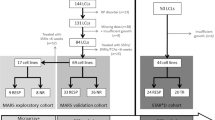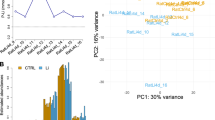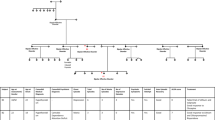Abstract
Lithium (Li) is the mainstay mood stabilizer for the treatment of bipolar disorder (BD), although its mode of action is not yet fully understood nor is it effective in every patient. We sought to elucidate the mechanism of action of Li and to identify surrogate outcome markers that can be used to better understand its therapeutic effects in BD patients classified as good (responders) and poor responders (nonresponders) to Li treatment. To accomplish these goals, RNA-sequencing gene expression profiles of lymphoblastoid cell lines (LCLs) were compared between BD Li responders and nonresponders with healthy controls before and after treatment. Several Li-responsive gene coexpression networks were discovered indicating widespread effects of Li on diverse cellular signaling systems including apoptosis and defense response pathways, protein processing and response to endoplasmic reticulum stress. Individual gene markers were also identified, differing in response to Li between BD responders and nonresponders, involved in processes of cell cycle and nucleotide excision repair that may explain part of the heterogeneity in clinical response to treatment. Results further indicated a Li gene expression signature similar to that observed with clonidine treatment, an α2-adrenoceptor agonist. These findings provide a detailed mechanism of Li in LCLs and highlight putative surrogate outcome markers that may permit for advanced treatment decisions to be made and for facilitating recovery in BD patients.
This is a preview of subscription content, access via your institution
Access options
Subscribe to this journal
Receive 6 print issues and online access
$259.00 per year
only $43.17 per issue
Buy this article
- Purchase on Springer Link
- Instant access to full article PDF
Prices may be subject to local taxes which are calculated during checkout



Similar content being viewed by others
References
Merikangas K, Jin R, He J, Kessler R, Lee S, Sampson N et al. Prevalence and correlates of bipolar spectrum disorder in the World Mental Health Survey Initiative. Arch Gen Psychiatry 2011; 68: 241.
Garnham J, Munro A, Slaney C, MacDougall M, Passmore M, Duffy A et al. Prophylactic treatment response in bipolar disorder: Results of a naturalistic observation study. J Affect Disord 2007; 104: 185–190.
Baldessarini R, Tondo L . Does lithium treatment still work? Arch Gen Psychiatry 2000; 57: 187.
Lewitzka U, Severus E, Bauer R, Ritter P, Müller-Oerlinghausen B, Bauer M . The suicide prevention effect of lithium: more than 20 years of evidence—a narrative review. Int J Bipolar Disord 2015; 3: 32.
Kleindienst N, Engel R, Greil W . Which clinical factors predict response to prophylactic lithium? A systematic review for bipolar disorders. Bipolar Disord 2005; 7: 404–417.
Serretti A, Lilli R, Lorenzi C, Gasperini M, Smeraldi E . Tryptophan hydroxylase gene and response to lithium prophylaxis in mood disorders. J Psychiatr Res 1999; 33: 371–377.
Turecki G, Grof P, Cavazzoni P, Duffy A, Grof E, Ahrens B et al. Evidence for a role of phospholipase C-γ1 in the pathogenesis of bipolar disorder. Mol Psychiatry 1998; 3: 534–538.
Rybakowski J, Suwalska A, Skibinska M, Szczepankiewicz A, Leszczynska-Rodziewicz A, Permoda A et al. Prophylactic lithium response and polymorphism of the brain-derived neurotrophic factor gene. Pharmacopsychiatry 2005; 38: 166–170.
Serretti A, Lilli R, Mandelli L, Lorenzi C, Smeraldi E . Serotonin transporter gene associated with lithium prophylaxis in mood disorders. Pharmacogenomics J 2001; 1: 71–77.
Masui T, Hashimoto R, Kusumi I, Suzuki K, Tanaka T, Nakagawa S et al. Lithium response and Val66Met polymorphism of the brain-derived neurotrophic factor gene in Japanese patients with bipolar disorder. Psychiatr Genet 2006; 16: 49–50.
Perlis R, Smoller J, Ferreira M, McQuillin A, Bass N, Lawrence J et al. A genomewide association study of response to lithium for prevention of recurrence in bipolar disorder. Am J Psychiatry 2009; 166: 718–725.
Squassina A, Manchia M, Borg J, Congiu D, Costa M, Georgitsi M et al. Evidence for association of an ACCN1 gene variant with response to lithium treatment in Sardinian patients with bipolar disorder. Pharmacogenomics 2011; 2: 1559–1569.
Chen CH, Lee CS, Lee MT, Ouyang WC, Chen CC, Chong MY et al. Variant GADL1 and response to lithium therapy in bipolar I disorder. N Engl J Med 2014; 370: 119–128.
Hou L, Heilbronner U, Degenhardt F, Adli M, Akiyama K, Akula N et al. Genetic variants associated with response to lithium treatment in bipolar disorder: a genome-wide association study. Lancet 2016; 387: 1085–1093.
Lenox R, Wang L . Molecular basis of lithium action: integration of lithium-responsive signaling and gene expression networks. Mol Psychiatry 2003; 8: 135–144.
Klein P, Melton D . A molecular mechanism for the effect of lithium on development. Proc Natl Acad Sci USA 1996; 93: 8455–8459.
Berridge M, Downes C, Hanley M . Neural and developmental actions of lithium: a unifying hypothesis. Cell 1989; 59: 411–419.
Lowthert L, Leffert J, Lin A, Umlauf S, Maloney K, Muralidharan A et al. Increased ratio of anti-apoptotic to pro-apoptotic Bcl2 gene-family members in lithium-responders one month after treatment initiation. Biol Mood Anxiety Disord 2012; 2: 15.
Beech R, Leffert J, Lin A, Sylvia L, Umlauf S, Mane S et al. Gene-expression differences in peripheral blood between lithium responders and non-responders in the Lithium Treatment-Moderate dose Use Study (LiTMUS). Pharmacogenomics J 2013; 14: 182–191.
Overstreet DH . Modeling depression in animal models. Methods Mol Biol 2012; 829: 125–144.
Harro J . Animal models of depression vulnerability. Curr Top Behav Neurosci 2013; 14: 29–54.
Abe K, St George-Hyslop PH, Tanzi RE, Kogure K . Induction of amyloid precursor protein mRNA after heat shock in cultured human lymphoblastoid cells. Neurosci Lett 1991; 125: 169–171.
Kobayashi H, Kruger R, Markopoulou K, Wszolek Z, Chase B, Taka H et al. Haploinsufficiency at the alpha-synuclein gene underlies phenotypic severity in familial Parkinson’s disease. Brain 2003; 126: 32–42.
Gutekunst CA, Levey AI, Heilman CJ, Whaley WL, Yi H, Nash NR et al. Identification and localization of huntingtin in brain and human lymphoblastoid cell lines with anti-fusion protein antibodies. Proc Natl Acad Sci USA 1995; 92: 8710–8714.
Koide R, Kobayashi S, Shimohata T, Ikeuchi T, Maruyama M, Saito M et al. A neurological disease caused by an expanded CAG trinucleotide repeat in the TAT-binding protein gene: a new polyglutamine disease? Hum Mol Genet 1999; 8: 2047–2053.
McEachin R, Chen H, Sartor M, Saccone S, Keller B, Prossin A et al. A genetic network model of cellular responses to lithium treatment and cocaine abuse in bipolar disorder. BMC Syst Biol 2010; 4: 158.
Hunsberger J, Chibane F, Elkahloun A, Henderson R, Singh R, Lawson J et al. Novel integrative genomic tool for interrogating lithium response in bipolar disorder. Transl Psychiatry 2015; 5: e504.
Sugawara H, Iwamoto K, Bundo M, Ishiwata M, Ueda J, Kakiuchi C et al. Effect of mood stabilizers on gene expression in lymphoblastoid cells. J Neural Transm 2010; 117: 155–164.
Asai T, Bundo M, Sugawara H, Sunaga F, Ueda J, Tanaka G et al. Effect of mood stabilizers on DNA methylation in human neuroblastoma cells. Int J Neuropsychopharmacol 2013; 16: 2285–2294.
Cruceanu C, Alda M, Grof P, Rouleau GA, Turecki G . Synapsin II is involved in the molecular pathway of lithium treatment in bipolar disorder. PLoS One 2012; 7: e32680.
Pearson W, Wood T, Zhang Z, Miller W . Comparison of DNA sequences with protein sequences. Genomics 1997; 46: 24–36.
Li H, Homer N . A survey of sequence alignment algorithms for next-generation sequencing. Brief Bioinform 2010; 11: 473–483.
Anders S, Pyl P, Huber W . HTSeq—a Python framework to work with high-throughput sequencing data. Bioinformatics 2014; 31: 166–169.
Law C, Chen Y, Shi W, Smyth G . voom: precision weights unlock linear model analysis tools for RNA-seq read counts. Genome Biol 2014; 15: R29.
Langfelder P, Horvath S . WGCNA: an R package for weighted correlation network analysis. BMC Bioinformatics 2008; 9: 559.
Breen M, Beliakova-Bethell N, Mujica-Parodi L, Carlson J, Ensign W, Woelk C et al. Acute psychological stress induces short-term variable immune response. Brain Behav Immun 2015; 53: 172–182.
Breen M, Maihofer A, Glatt S, Tylee D, Chandler S, Tsuang M et al. Gene networks specific for innate immunity define post-traumatic stress disorder. Mol Psychiatry 2015; 20: 1538–1545.
Kayala M, Baldi P . Cyber-T web server: differential analysis of high-throughput data. Nucleic Acids Res 2012; 40: W553–W559.
Chen J, Bardes E, Aronow B, Jegga A . ToppGene Suite for gene list enrichment analysis and candidate gene prioritization. Nucleic Acids Res 2009; 37: W305–W311.
Du Z, Li L, Chen C, Yu P, Wang J . G-SESAME: web tools for GO-term-based gene similarity analysis and knowledge discovery. Nucleic Acids Res 2009; 37: W345–W349.
Yoo M, Shin J, Kim J, Ryall K, Lee K, Lee S et al. DSigDB: drug signatures database for gene set analysis. Bioinformatics 2015; 31: 3069–3071.
Yaari G, Bolen C, Thakar J, Kleinstein S . Quantitative set analysis for gene expression: a method to quantify gene set differential expression including gene-gene correlations. Nucleic Acids Res 2013; 41: e170–e170.
Franceschini A, Szklarczyk D, Frankild S, Kuhn M, Simonovic M, Roth A et al. STRING v9.1: protein-protein interaction networks, with increased coverage and integration. Nucleic Acids Res 2012; 41: D808–D815.
Shannon P . Cytoscape: a software environment for integrated models of biomolecular interaction networks. Genome Res 2003; 13: 2498–2504.
Watanabe S, Iga J, Nishi A, Numata S, Kinoshita M, Kikuchi K et al. Microarray analysis of global gene expression in leukocytes following lithium treatment. Hum Psychopharmacol 2014; 29: 190–198.
Zhang W, Jüllig M, Connolly A, Stott N . Early gene response in lithium chloride induced apoptosis. Apoptosis 2005; 10: 75–90.
Ghribi O, Herman M, Spaulding N, Savory J . Lithium inhibits aluminum-induced apoptosis in rabbit hippocampus, by preventing cytochrome c translocation, Bcl-2 decrease, Bax elevation and caspase-3 activation. J Neurochem 2002; 82: 137–145.
Yeste M, Alvira D, Verdaguer E, Tajes M, Folch J, Rimbau V et al. Evaluation of acute antiapoptotic effects of Li+ in neuronal cell cultures. J Neural Transm 2006; 114: 405–416.
Hiroi T, Wei H, Hough C, Leeds P, Chuang D . Protracted lithium treatment protects against the ER stress elicited by thapsigargin in rat PC12 cells: roles of intracellular calcium, GRP78 and Bcl-2. Pharmacogenomics J 2005; 5: 102–111.
Mattson M, LaFerla F, Chan S, Leissring M, Shepel P, Geiger J . Calcium signaling in the ER: its role in neuronal plasticity and neurodegenerative disorders. Trends Neurosci 2000; 23: 222–229.
Sherman M, Goldberg A . Cellular defenses against unfolded proteins. Neuron 2001; 29: 15–32.
Paschen W . Endoplasmic reticulum: a primary target in various acute disorders and degenerative diseases of the brain. Cell Calcium 2003; 34: 365–383.
Jing P, Zhang J, Ouyang Q, Wu J, Zhang X . Lithium treatment induces proteasomal degradation of over-expressed acetylcholinesterase (AChE-S) and inhibit GSK3β. Chem -Biol Interact 2013; 203: 309–313.
Bosetti F, Seemann R, Rapoport S . Chronic lithium chloride administration to rats decreases brain protein level of epsilon (ε) subunit of eukaryotic initiation factor-2B. Neurosci Lett 2002; 327: 71–73.
Karyo R, Eskira Y, Pinhasov A, Belmaker R, Agam G, Eldar-Finkelman H . Identification of eukaryotic elongation factor-2 as a novel cellular target of lithium and glycogen synthase kinase-3. Mol Cell Neurosci 2010; 45: 449–455.
Stilling R, Ronicke R, Benito E, Urbanke H, Capece V, Burkhardt S et al. K-Lysine acetyltransferase 2a regulates a hippocampal gene expression network linked to memory formation. EMBO J 2014; 33: 1912–1927.
Semba J, Watanabe H, Suhara T, Akanuma N . Chronic lithium chloride injection increases glucocorticoid receptor but not mineralocorticoid receptor mRNA expression in rat brain. Neurosci Res 2000; 38: 313–319.
Manji H, Lenox R . Long-term action of lithium: a role for transcriptional and posttranscriptional factors regulated by protein kinase C. Synapse 1994; 16: 11–28.
Vance JE, Steenbergen R . Metabolism and functions of phophatidylserine. Prog Lipid Res 1994; 44: 207–234.
Gupta A, Schulze T, Nagarajan V, Akula N, Corona W, Jiang X et al. Interaction networks of lithium and valproate molecular targets reveal a striking enrichment of apoptosis functional clusters and neurotrophin signaling. Pharmacogenomics J 2011; 12: 328–341.
Ming X, Mulvey M, Mohanty S, Patel V . Safety and efficacy of clonidine and clonidine extended-release in the treatment of children and adolescents with attention deficit and hyperactivity disorders. Adolesc Health Med Ther 2011; 2: 105–112.
Jaselskis C, Cook E, Fletcher K, Leventhal B . Clonidine treatment of hyperactive and impulsive children with autistic disorder. J Clin Psychopharmacol 1992; 12: 322–327.
Matussek N, Ackenheil M, Hippius H, Müller F, Schröder H, Schultes H et al. Effect of clonidine on growth hormone release in psychiatric patients and controls. Psychiatry Res 1980; 2: 25–36.
Dehpour A, Sadr S, Azizi M, Namiranian K, Farahani1 M, Javidan A . Lithium inhibits the development of physical dependence to clonidine in mice. Pharmacol Toxicol 2002; 90: 89–93.
Price LH, Heninger GR . Lithium in the treatment of mood disorders. N Engl J Med 1994; 331: 591–598.
Wheeler H, Dolan M . Lymphoblastoid cell lines in pharmacogenomic discovery and clinical translation. Pharmacogenomics 2012; 13: 55–70.
Shim S, Nam H, Lee J, Kim J, Han G, Jeon J . MicroRNAs in human lymphobastoid cell lines. Crit Rev Eukayoti Gene Expr 2012; 22: 189–196.
Sie L, Loong S, Tan E . Utility of lymphoblastoid cell lines. J Neurosci Res 2009; 87: 1953–1959.
Min J, Barrett A, Watts T, Pettersson F, Lockstone H, Lindgren C et al. Variability of gene expression profiles in human blood and lymphoblastoid cell lines. BMC Genomics 2010; 11: 96.
Acknowledgements
We thank Drs D Baldwin and AS Breen for critical reading of our manuscript, Wei Wei Chiu for wet-lab support and our anonymous reviewers for highly constructive comments. This work was funded by grants to John R Kelsoe from the NIMH and the Department of Veterans Affairs.
Author information
Authors and Affiliations
Corresponding authors
Ethics declarations
Competing interests
The authors declare no conflict of interest.
Additional information
Supplementary Information accompanies the paper on the The Pharmacogenomics Journal website
Supplementary information
Rights and permissions
About this article
Cite this article
Breen, M., White, C., Shekhtman, T. et al. Lithium-responsive genes and gene networks in bipolar disorder patient-derived lymphoblastoid cell lines. Pharmacogenomics J 16, 446–453 (2016). https://doi.org/10.1038/tpj.2016.50
Received:
Revised:
Accepted:
Published:
Issue Date:
DOI: https://doi.org/10.1038/tpj.2016.50
This article is cited by
-
Temporal effects on death by suicide: empirical evidence and possible molecular correlates
Discover Mental Health (2023)
-
Disease-specific differences in gene expression, mitochondrial function and mitochondria-endoplasmic reticulum interactions in iPSC-derived cerebral organoids and cortical neurons in schizophrenia and bipolar disorder
Discover Mental Health (2023)
-
Transcriptomics and miRNomics data integration in lymphoblastoid cells highlights the key role of immune-related functions in lithium treatment response in Bipolar disorder
BMC Psychiatry (2022)
-
Translational evidence for lithium-induced brain plasticity and neuroprotection in the treatment of neuropsychiatric disorders
Translational Psychiatry (2021)
-
Lithium increases mitochondrial respiration in iPSC-derived neural precursor cells from lithium responders
Molecular Psychiatry (2021)



